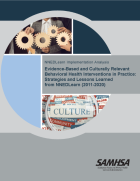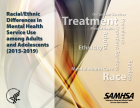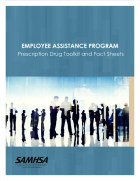This report provides findings from a qualitative analysis of evidence-based and culturally relevant behavioral health practices offered at NNEDLearn, a SAMHSA training, offered from 2011 to 2020. It includes an overview of NNEDLearn, case studies, strategies and lessons learned, and conclusion.
Dashboard: Filter Bricks
Main page content


This chartbook uses combined 2015 to 2019 data from the National Survey on Drug Use and Health (NSDUH) to present nationally representative estimates of mental health service utilization among adults aged 18 or older and adolescents aged 12 to 17 within different racial/ethnic groups in the United States. The percentages are annual averages.

This Advisory is based on TIP 55, Behavioral Health Services for People Who Are Homeless. It addresses the fundamentals of how providers and administrators can employ approaches to address the complex challenges of providing integrated treatment services to clients experiencing homelessness.

The EAP Prescription Drug Toolkit and Fact Sheets provide guidance related to counseling, referrals, and follow-up services (e.g., alternatives to prescription drugs, workplace drug misuse and relapse prevention, dangers of combined drug use, screenings, and evaluations before returning to work).

The book is composed of SAMHSA’s “National Guidelines for Behavioral Health Crisis Care: Best Practice Toolkit” and related papers on crisis services. The toolkit reflects relevant clinical and health services research, review of top national program practices and replicable approaches that support best practice implementation. The related papers address key issues relevant to crisis services, homelessness, technology advances, substance use, legal issues impacting crisis services, financing crisis care, diverse populations, children and adolescents, rural and frontier areas, and the role of law enforcement.

Disaster survivors are not always aware of behaviors in themselves or others that are associated with adverse reactions to a disaster. This poster assists adult disaster survivors with identifying possible reactions and provides resources to turn to for help.
Los sobrevivientes de acontecimientos catastróficos no siempre están conscientes de los comportamientos, sea en sí mismos o en otras personas, que están relacionados con reacciones adversas a estas experiencias. Este póster ayuda a los adultos que han sobrevivido un acontecimiento catastrófico a ide.

This updated manual contains a 12-week cognitive–behavioral anger management group treatment model. The content includes specific instructions and suggested remarks for group leaders, and exercises for group members. This model will work in a variety of clinical settings, and with diverse audiences.

Entendamos el trauma infantil
This infographic is a Spanish language version of information for the general public on the prevalence and impact of traumatic events on children, and what actions can be taken to support children who experience traumatic events.

This brochure explains the signs and symptoms of retraumatization. Gives guidance on how to manage the symptoms. It provides resources for building resilience and an adequate support system for dealing with triggering events.

The SAMHSA Spotlight Series highlights different approaches to building trauma-informed, resilient communities. This issue highlights how school-based health services in Walla Walla, Washington, are treating adverse childhood experiences and building community resilience.
Displaying 1 - 10 out of 42

